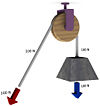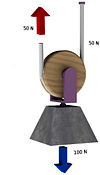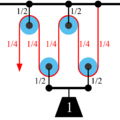Pulley
<<This article doesn't have any references.>>
Pulleys are usually used in sets designed to reduce the amount of force needed to lift a load. However, the same amount of work is necessary for the load to reach the same height as it would without the pulleys. The magnitude of the force is reduced, but it must act through a longer distance. The effort needed to pull a load up is roughly the weight of the load divided by the number of wheels. The more wheels there are, the less efficient a system is, because of more friction between the rope and the wheels. Pulleys are one of the six simple machines.
Cranes and flag raisers both use pulleys. <<Please give more examples of where pulleys are used in a separate section (below), and summarize the main examples up here as well.>>
History
<<Please add some more info about the history of pulleys.>>
It is not recorded when or by whom the pulley was first developed. It is believed however that Archimedes developed the first documented block and tackle pulley system, as recorded by Plutarch. Plutarch reported that Archimedes moved an entire warship, laden with men, using compound pulleys and his own strength.
Types of pulleys
- Fixed A fixed or class 1 pulley has a fixed axle. That is, the axle is "fixed" or anchored in place. A fixed pulley is used to redirect the force in a rope (called a belt when it goes in a full circle). A fixed pulley has a mechanical advantage of 1.
- Movable A movable or class 2 pulley has a free axle. That is, the axle is "free" to move in space. A movable pulley is used to transform forces. A movable pulley has a mechanical advantage of 2. That is, if one end of the rope is anchored, pulling on the other end of the rope will apply a doubled force to the object attached to the pulley.
- Compound A compound pulley is a combination fixed and movable pulley system.
- Block and tackle - A block and tackle is a compound pulley where several pulleys are mounted on each axle, further increasing the mechanical advantage.
Pulleys are able to change the direction of the force.
Theory of operation
The simplest theory of operation for a pulley system assumes that the pulleys and lines are weightless, and that there is no energy loss due to friction. It is also assumed that the lines do not stretch. With this assumption, it follows that, in equilibrium, the total force on the pulley must be zero. This means that the force on the axle of the pulley is shared equally by the two lines looping through the pulley. The situation is schematically illustrated in diagram 1. For the case where the lines are not parallel, the tensions in each line are still equal, but now the vector sum of all forces is zero. A second basic equation for the pulley follows from the conservation of energy: The product of the weight lifted times the distance it is moved is equal to the product of the lifting force (the tension in the lifting line) times the distance the lifting line is moved. The weight lifted divided by the lifting force is defined as the advantage of the pulley system. It is important to notice that the amount of work done in an ideal pulley is always the same. The work is given by the effort times the distance moved. The pulley simply allows trading effort for distance.
In diagram 2, a single movable pulley allows a unit weight to be lifted with only half the force needed to lift the weight without assistance. The total force needed is divided between the lifting force (red arrow) and the "ceiling" which is some immovable object (such as the earth). In this simple system, the lifting force is directed in the same direction as the movement of the weight. The advantage of this system is 2. Although the force needed to lift the unit weight is only half of the unit weight, we will need to draw a length of rope that is twice the distance that the weight is lifted, so that the total amount of work done (Force x distance) remains the same.
A second pulley may be added as in diagram 2a, which simply serves to redirect the lifting force downward, it does not change the advantage of the system.
The addition of a fixed pulley to the single pulley system can yield an increase of advantage. In diagram 3, the addition of a fixed pulley yields a lifting advantage of 3. The tension in each line is ⅓ the unit weight, and the force on the axles of each pulley is ⅔ of a unit weight. As in the case of diagram 2a, another pulley may be added to reverse the direction of the lifting force, but with no increase in advantage. This situation is shown in diagram 3a.
This process can be continued indefinitely for ideal pulleys with each additional pulley yielding a unit increase in advantage. For real pulleys friction among rope and pulleys will increase as more pulleys are added to the point that no advantage is possible. It puts a limit for the number of pulleys we can use in practice. The above pulley systems are known collectively as block and tackle pulley systems. In diagram 4a, a block and tackle system with advantage 4 is shown. A practical implementation in which the connection to the ceiling is combined and the fixed and movable pulleys are encased in single housings is shown in figure 4b.
Other pulley systems are possible, and some can deliver an increased advantage with fewer pulleys than the block and tackle system. The advantage of the block and tackle system is that each pulley and line is subjected to equal tensions and forces. Efficient design dictates that each line and pulley be capable of handling its load, and no more. Other pulley designs will require different strengths of line and pulleys depending on their position in the system, but a block and tackle system can use the same line size throughout, and can mount the fixed and movable pulleys on a common axle.
Uses of pulleys
<<It would be good to provide more examples of where pulleys are used and to summarize their uses in the opening paragraphs of the article.>>
Cranes and flag raisers both use pulleys.
See also
- Hoist
- Reel
- Winch
ReferencesISBN links support NWE through referral fees
<<We need at least 3 reliable references here, properly formatted.>>
External links
<<Some significant Web links would also be helpful.>>
Credits
New World Encyclopedia writers and editors rewrote and completed the Wikipedia article in accordance with New World Encyclopedia standards. This article abides by terms of the Creative Commons CC-by-sa 3.0 License (CC-by-sa), which may be used and disseminated with proper attribution. Credit is due under the terms of this license that can reference both the New World Encyclopedia contributors and the selfless volunteer contributors of the Wikimedia Foundation. To cite this article click here for a list of acceptable citing formats.The history of earlier contributions by wikipedians is accessible to researchers here:
The history of this article since it was imported to New World Encyclopedia:
Note: Some restrictions may apply to use of individual images which are separately licensed.










